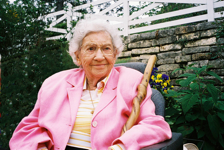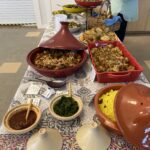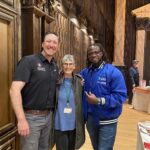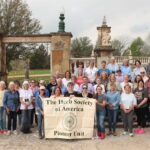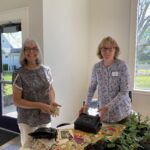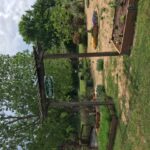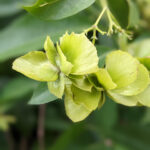She Grew Where She Was Planted: The Life of Madalene Hill (1913-2009 )
Madalene Hill was one of the rare gardeners who truly became a legend in her own time. Known to many as the “Grand Dame of Herbs” in the South, she was a pioneer who blazed a path so that many who followed her could learn to appreciate, grow, and use the “little plants” that she dearly loved.
Madalene was born in Rock Island, Texas (south of Columbus) on November 7th, 1913. Her maternal grandparents had settled in the area and, like most residents, were rice farmers. At the age of three, she moved with her mother and younger brother to Kansas to live with relatives. Being the eldest of 13 children, she developed a strong work ethic and left high school at the age of 16 to help support the family. She worked for the Federal Land Bank in Wichita just as the depression hit and times got really hard for the agrarian communities of the Midwest.
In 1933, she married, and in 1935 moved to Houston with her husband and young son Jerry. Her daughter Gwen was born two years later. Using her training as a key punch operator at the Land Bank, Madalene went to work at American General Insurance Company in Houston. When her marriage ended she was the sole bread winner for the family of three. As World War II broke out she went to work at the Brown Shipyard in the payroll department and following the war worked for IBM, being the first female office manager (from 1949 to 1951).
In 1951, she married Jim Hill, who was an avid gardener and cook. In 1957 they both “retired” and moved to land purchased near Cleveland, TX. Jim’s retirement project was to grow gladiolas on a commercial scale for florists. After two years of preparation they planted 200,000 gladiolus corms, with first harvest in time for Mother’s Day.
Even as they prepared for this gladiolus experiment they raised vegetables and herbs for their own use. Madalene had grown up using herbs such as dill and sage and they were always a part of her cooking. At the time sources for herb plants and seeds were scarce. In 1957 she joined The Herb Society of America, the second member to join from Texas and with a letter of recommendation from the Mayor of Houston. With this group she was able to exchange seeds with other members, but even then the variety of plants was small.
She and Jim recognized a growing interest in herbs, especially ones like oregano and chives, following the war, and started to grow and sell herbs at what they now called Hilltop Herb Farm. With the farm’s remote rural location they started on a small scale to feed hungry customers with herb-flavored lunches and this led to the creation of their restaurant business in 1967, which attracted customers from near and far. You would think that this would be enough to keep a “retired” person busy, but not Madalene. She also started to lecture and write about herbs, as well as travel and communicate with other herb fanciers to learn and collect more. In 1968 she, along with friend Rexford Talbert, co-founded The Herb Society of America, South Texas Unit which is based in Houston and later, in 1994, became a founding member of The Herb Society of America, Pioneer Unit based in Round Top.
By the early 1980’s the array of herbs available to the public in America was vastly expanded, but it was then that disaster struck. In 1982 Jim passed away and in 1983 the Farm was destroyed by a December tornado. Madalene, along with daughter Gwen, rebuilt Hilltop and also opened a restaurant in Houston, but in 1987 they decided to get out of the restaurant business and sold the farm.
In 1987 Madalene and Gwen published their classic book Southern Herb Growing and started to do a lot of traveling and lecturing. Madalene also served as The Herb Society of America President from 1986-1988.
In 1993 Gwen became Director of Food Services for The International Festival-Institute in Round Top, with Madalene becoming a “full time volunteer” as Curator of the Susan McAshan Gardens. Always the consummate gardener, Madalene brought along many potted herbs and set about creating new gardens to enhance the grounds and provide fresh herbs for the kitchen. During her tenure, the gardens expanded to include a wonderful array of rare plants, large herb collections, and theme gardens such as a Mediterranean Garden, Mary Garden, Shakespeare Garden, and her crown jewel – the Pharmacy Garden, dedicated in her honor.
Though she never went to college to study, teachers, herbalists, and common gardeners across the country would consult her as an authority for information about herbs and other plants. Gardens were named in her honor and she received a plethora of awards and medals for her achievements, but she said that her greatest honor was “to have been the facilitator for the introduction of culinary herbs and herbs for the landscape to so many through the years. These small fragrant plants have changed the lives of so many.” She has been credited with introducing herbs such as Mexican Mint Marigold, ‘Hilltop’ Oregano, ‘Arp’ Rosemary, ‘Madalene Hill’ Doublemint, and ‘Newe Ya’ar’ Sage to the Texas and American markets. The rosemary ‘Hill Hardy’ was named in her honor by a fellow herb grower.
Whenever she would autograph her book she would write the saying “Grow Where You are Planted.” Throughout all the ups and downs of her 95 years, she did just that and became a great inspiration for her family, friends, coworkers, and a multitude of gardeners across Texas, the United States, and around the world.
Henry Flowers




